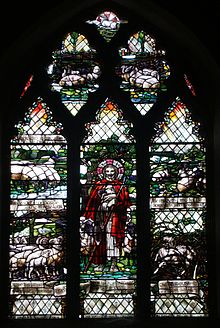Christopher Whall
| Christopher Whall | |
|---|---|

"The Good Shepherd" (1902),
St Ethelbert. Herringswell. Suffolk |
|
| Born | 1849 Thurning, Northamptonshire, England |
| Died | 23 December 1924 |
| Nationality | English |
| Education | Attended Rossall School, Royal Academy Schools in London |
| Known for | Stained glass |
| Notable work | Stained glass windows, which often served as war memorials |
Christopher Whitworth Whall (1849–1924) was an English stained glass artist who worked from the 1880s and on into the 20th century and is widely recognised as one of the key figures in the modern history of stained glass.
One of Whall's best known dictums was "the design of the window must relate to the architecture of the frame".
Christopher Whall was born in the rectory at Thurning, Northamptonshire, where his father was the rector. In 1863 he was sent to Rossall School in Lancashire. The drawing master there was William Coulter of the Royal Hibernian Academy. He left Rossall School in 1865, and in 1867 enrolled as a probationer at the Royal Academy Schools. On 8 January 1868 he was admitted as a student there - which was incidentally a professional path taken against his parents' wishes.
In 1874 Whall met the designer, A. H. Mackmurdo, founder of the Century Guild, and through him Selwyn Image, and contributed to the Guild's publication, Hobby Horse. In 1875 and 1876 he exhibited at the Royal Academy. At this time he gained the patronage of a Hanoverian, Baroness von Boselager, who gave him funds to travel to Italy, where he was to stay for almost three years, travelling in central and northern Italy, studying architecture and paintings. In 1878 in Lucca he converted to Catholicism. Before going to Italy he had sought work as a portrait painter and as a studio assistant to other artists, but had had little success.
When he returned to London in 1879, almost penniless, he was befriended by the Rosminian Order of Charity at St Ethelreda's Church in Ely Place, Holborn and became a lay member of that Order. At St Ethelreda's he designed the side windows in the upper chapel, these windows being made by W.G. Saunders. By 1882 he was to leave the religious community at Ely Place, move to No.18 Wharton Street in Clerkenwell and work as an illustrator of newspapers, novels and children's books, as well as assisting other painters and giving drawing lessons. He carried out designs during this period for several stained glass makers including John Hardman Trading Co. Ltd as well as James Powell and Sons.
...
Wikipedia
